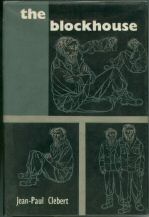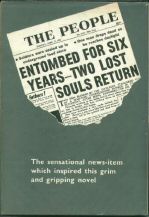Secker and Warburg edition 1958 –
first published by
Editions Denoel, Paris, 1955
THE BLOCKHOUSE
During the bombardment following the Allied landings in Normandy in 1944, six Frenchmen working for the Germans as forced labourers take refuge in a deserted blockhouse. No sooner have they hidden themselves than the entrance is blocked by an exploding shell. At first they are in the dark: Rouquet, a mild schoolmaster; Turenne, a miner by profession; Aufret, the self-imposed, bombastic leader soon to be eclipsed by Grabinski, the strongest, most resourceful. It is he who finds matches, whereupon they discover themselves in a supply depot stacked with food, wine and clothing. Though there is no way out, they will not die yet.
Now begins their life together, the development of their relations to each other, the various ways they distract themselves. Visconti draws an obscene design on the wall: Cauvin finds a bicycle. We share their gradual change from ordinary human beings into barely recognisable cavemen, and after the first death it becomes clear that whoever survives will do so because somehow he has been able to preserve a spark of human feeling.
THE AUTHOR
Jean-Paul Clébert was born in Paris in 1926. Writing of himself he says: “My secondary education was interrupted by the war but continued as a prisoner. I have never had a regular job but have been successively: house painter, cook, newspaper seller, farm worker, navvy undertaker’s mute, valet de pied, cafe proprietor and tramp. Lived for some years with gipsies and am now engaged on writing a book about them. Have also travelled widely in the East. I now live alone on a farm in Haute Provence.”
The Blockhouse is M. Clébert’s third book, and his first to be translated into English.
And then I was thinking about this some more
Re: [timegoggles]
Re:Unexpected Book
From: Greg Pickersgill <gregory@gostak.demon.co.uk>
Date:
Mon, 16 Mar 2009 11:20:28 +0000
Somebody mentioned obscure. Well, there's this
book, see...
For years - decades even - I had been slightly obsessed by a book
titled
THE BLOCKHOUSE, by some foreign character name of Jean-Paul Clebert. This was
all down to seeing an ad for the SFBC (see here,
although I believe the ad I originally saw was in a BRE ASF) in which it was
featured as an upcoming issue. I was fascinated; "Translated from the
French" it said, about "a group of men ... entombed for six
years...how the lucky ones died and two monsters who survived". Wow, you
gotta know, don't you? I came by other mentions of the book as well, which
intimated that it was a sort-of WW2 thing, which interested me even more. But
what really fascinated me was that after years of looking and collecting it
became
clear the book had never been issued by SFBC. You can see the true facts,
discovered many years later, at the page referenced above.
Anyway, time passes and a few years back I get a copy of the book itself. Which is interesting but unremarkable, and possibly handicapped by a dull translation. The background to the book is somewhat obscure, but there's a general insistence that it is based on a true story; indeed the UK edition has on its back jacket a representation of the front page of "The People" newspaper for 17th June 1951 purporting to give the full story and pix. The book itself was first published in France in 1955, and the 1957 UK edition has jacket copy asserting "After the war a sensational new-item appeared on which M. Clebert's novel is based." At about the same time I got the book I became aware that there's actually a film based on it, made in 1973. More years pass until last week, when I actually buy a copy of the film (THE BLOCKHOUSE, as one might imagine) on dvd. Which I haven't seen yet so nothing more about that for the moment. This however all reminds me of something I saw in passing while researching some other film (Die Brucke, as a matter of fact).
I'd come across this, which leads you to a German movie entitled NASSER ASPHALT (nothing to do with Egypt, perhaps startlingly, but actually transliterated as"Wet Asphalt") which for those too idle to goto is described as "A blind German soldier, the sole survivor of a group trapped in an underground bunker at the end of World War II, escapes after six years and becomes a national sensation. But when the assistant to the reporter who broke the story discovers a shocking secret, he is torn between his loyalty to his mentor and the truth." Well, there's interesting, that sounds like THE BLOCKHOUSE, doesn't it, and I was quite fascinated with this when I found it a couple ofyears back. It led me on to a archived TIME magazine report dated June1951 - hand a similar one in the N.Y. Times also dated June 1951.
The basic facts given in the TIME story are indeed those used in THE BLOCKHOUSE, although the setting in both book and film is shifted from Poland to the Normandy coast, where the characters are entombed during the bombardment immediately preceding the landings in 1944. Further poking about revealed that there were indeed massive bunker installations at Babie Doly, so so far not so impossible.But let's backtrack to NASSER ASPHALT a minute. The "shocking secret" referred to is that the whole story of the bunker and its survivors is a complete fantasy, simply made up for financial and prestige gain via sales to gullible newspapers. So what's the backstory to that then? It seems like a pretty unlikely thing to base a film around unless it actually has some root in observable reality; is it simply a flash of inspiration turnaround of the reporting of the Babie Doly event, or is it actually the truth revealed, that in fact there was NO incredible discovery, that the whole thing had been made up by a typically unscrupulous journalist? Well, I dunno; there are it appears limits as to what the jiant brane of the interweb can tell me. Or I may be simply asking the wrong questions in the wrong language. But you gotta admit, you do sort of want to know, don't you?
Greg Pickersgill

